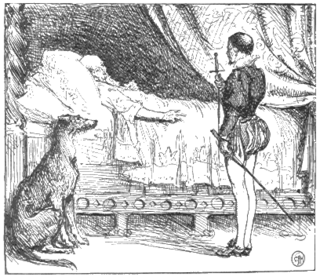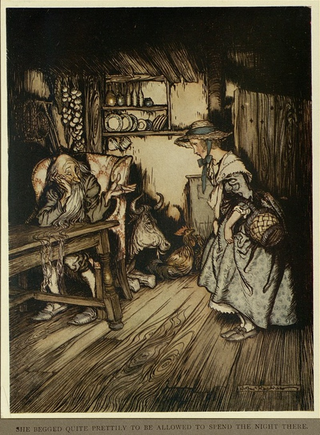Related Research Articles

"Snow-White and Rose-Red" is a German fairy tale. The best-known version is the one collected by the Brothers Grimm. An older, somewhat shorter version, "The Ungrateful Dwarf", was written by Caroline Stahl (1776–1837). Indeed, that appears to be the oldest variant; no previous oral version is known, although several have been collected since its publication in 1818. Oral versions are very limited regionally. The tale is of Aarne-Thompson type 426.
The Aarne–Thompson–Uther Index is a catalogue of folktale types used in folklore studies. The ATU Index is the product of a series of revisions and expansions by an international group of scholars: originally composed in German by Finnish folklorist Antti Aarne (1910), the index was translated into English, revised, and expanded by American folklorist Stith Thompson, and later further revised and expanded by German folklorist Hans-Jörg Uther (2004). The ATU Index, along with Thompson's Motif-Index of Folk-Literature (1932)—with which it is used in tandem—is an essential tool for folklorists.
"Cap-o'-Rushes" is an English fairy tale published by Joseph Jacobs in English Fairy Tales.

"Trusty John", "Faithful John", "Faithful Johannes", or "John the True" is a German fairy tale collected by the Brothers Grimm and published in Grimm's Fairy Tales in 1819. Andrew Lang included it in The Blue Fairy Book.

"The Wolf and the Seven Young Goats" is a fairy tale collected by the Brothers Grimm and published in Grimm's Fairy Tales. It is of Aarne-Thompson type 123 "The Wolf and the Kids".

"The Hut in the Forest" is a German fairy tale collected by the Brothers Grimm. Andrew Lang included it in The Pink Fairy Book (1897). It is Aarne-Thompson type 431.

The Lute Player, The Tsaritsa Harpist or The Tsaritsa who Played the Gusli, is a Russian fairy tale. It was published by Alexander Afanasyev in his collection Russian Fairy Tales, as number 338. Andrew Lang included it in The Violet Fairy Book (1901).
"The Four Skillful Brothers" is a German fairy tale collected by the Brothers Grimm. It is Aarne-Thompson type 653.
"The Hazelnut Child" is a Bukovinian fairy tale collected by the Polish-German scholar Heinrich von Wlislocki (1856–1907) in Märchen Und Sagen Der Bukowinaer Und Siebenbûrger Armenier. Andrew Lang included it in The Yellow Fairy Book (1894) and Ruth Manning-Sanders included it in A Book of Dwarfs (1964).
The Little Bull-Calf is an English Romani fairy tale collected by Joseph Jacobs in More English Fairy Tales.
"Mossycoat" is a fairy tale published by Katherine M. Briggs and Ruth Tongue in Folktales of England. It appears in A Book of British Fairy Tales by Alan Garner. The story known by folklorists was collected by researcher T. W. Thompson from teller Taimi Boswell, a Romani, at Oswaldtwistle, Lancashire, January 9, 1915.
Little Catskin is an American fairy tale from Kentucky, collected by Marie Campbell in Tales from the Cloud Walking Country, listing her informant as Big Nelt.

Little Wildrose is a Romanian fairy tale. Andrew Lang included it in The Crimson Fairy Book.
The Spinning-Woman by the Spring or The Kind and the Unkind Girls is a widespread, traditional folk tale, known throughout Europe and in certain regions of Asia, including Indonesia. The tale is cataloged as AT 480 in the international Folktale catalog.

"Puss in Boots" is a European fairy tale about an anthropomorphic cat who uses trickery and deceit to gain power, wealth, and the hand in marriage of a princess for his penniless and low-born master.
How the Killing of the Old Men Was Stopped is a Serbian fairy tale that first appeared in Kazadzic, a journal of Serbian folklore, having been submitted by Mr. I. L. Szeckovic from Paracin. It is Aarne-Thompson type 981, "Wisdom of Hidden Old Man Saves Kingdom."

The Jew Among Thorns, also known as The Jew in the Brambles, is an antisemitic fairytale collected by the Brothers Grimm. It is a tale of Aarne–Thompson type 592. A similar antisemitic tale in the collection is The Good Bargain.
In folkloristics, "The Animal as Bridegroom" refers to a group of folk and fairy tales about a human woman marrying or being betrothed to an animal. The animal is revealed to be a human prince in disguise or under a curse. Most of these tales are grouped in the international system of Aarne-Thompson-Uther Index under type ATU 425, "The Search for the Lost Husband". Some subtypes exist in the international classification as independent stories, but they sometimes don't adhere to a fixed typing.
The Fire Boy is a Japanese folktale collected by scholar Seki Keigo. It tells of a boy expelled from home to another realm and, thanks to the efforts of a faithful horse, marries a lord's daughter.
The Golden Eggplant is a Japanese folktale, published by scholar Seki Keigo in Folktales of Japan. Scholars relate it to tale type ATU 707, "The Three Golden Children", of the international Aarne-Thompson-Uther Index.
References
- ↑ "People - Department of German - University of Pittsburgh". german.pitt.edu. Retrieved January 19, 2018.
- 1 2 3 "Sussex Centre for Folklore, Fairy Tales and Fantasy". University of Chichester . Retrieved January 19, 2018.
- ↑ "1940 U.S. Federal Population Census". Census Bureau. 1940. Retrieved January 19, 2018.
- ↑ "Obituary - Elgarda Zobell Ashliman". Rexburg Standard Journal. August 10, 2004.
- ↑ "ICL Course Catalog" (PDF). Dixie State College. 2018. p. 14. Retrieved September 7, 2018.
- ↑ "Dee Ashliman Marriage and Divorce Records" . Retrieved January 19, 2018.[ permanent dead link ]
- 1 2 Gale (2009). "Ashliman, D. L. 1938-". Contemporary Authors. Encyclopedia.com . Retrieved January 19, 2018.
- ↑ Ashliman, D. L. (1969). The American West in nineteenth-century German literature in SearchWorks. searchworks.stanford.edu (Thesis). Retrieved November 24, 2015.
- ↑ "D.L. Ashliman's Home Page". University of Pittsburgh. February 17, 2010. Retrieved January 19, 2018.
- ↑ De Masters, Tiffany (December 30, 2009). "Classes have seniors in mind". The Spectrum. Newspapers.com. p. 1. Retrieved September 7, 2018.
- ↑ "ICL Course Catalog" (PDF). Dixie State College. 2018. pp. 6, 19. Retrieved September 7, 2018.
- ↑ Roncevic, Mirela (September 1, 2004). "Review of Folk and Fairy Tales". Library Journal: 118. OCLC 36096783.
- ↑ D. L. Ashliman (April 9, 2016). "The Grimm Brothers' Children's and Household Tales". University of Pittsburgh. Retrieved September 7, 2018.
- ↑ Dianne de Las Casas (2006). Story Fest: Crafting Story Theater Scripts. Westport, Connecticut: Teacher Ideas Press, p. 73. ISBN 1-59469-009-X.
- ↑ "Sussex Centre for Folklore, Fairy Tales and Fantasy: People". University of Chichester. Retrieved November 25, 2015.